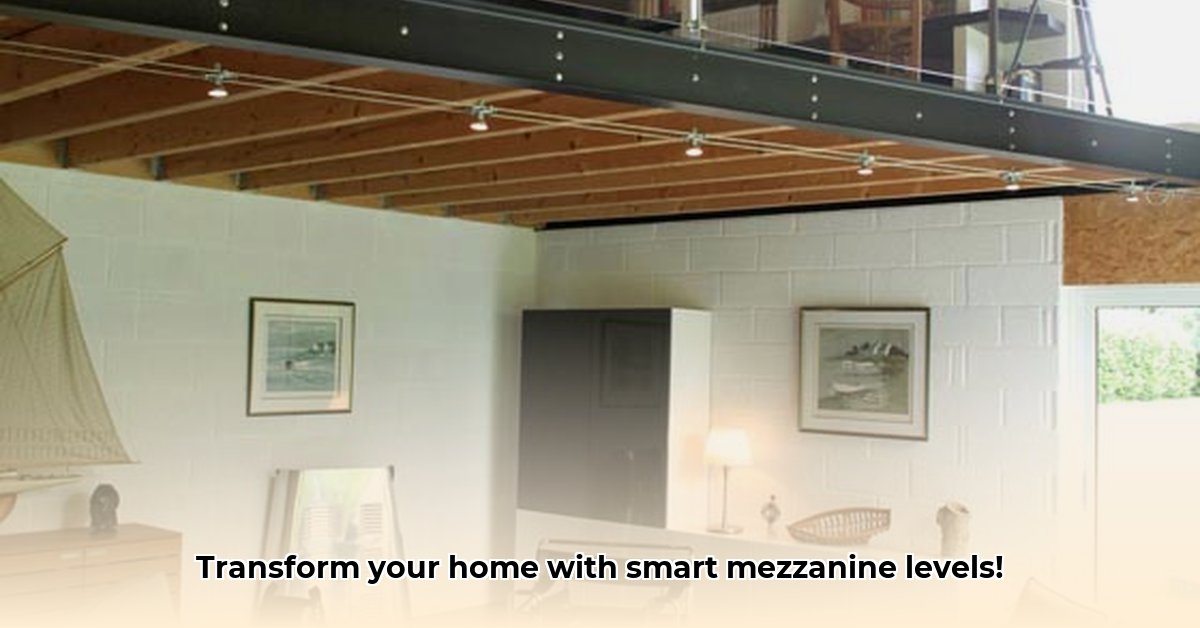Want to maximize your living space without the hassle of moving? A mezzanine level is a brilliant solution! This guide provides a comprehensive overview of mezzanine design, blending aesthetic appeal and practical functionality to help homeowners, architects, and builders transform living spaces. We’ll explore essential considerations, creative designs, and actionable strategies to make your mezzanine project a success. For more fantastic ideas, check out these mezzanine floor ideas.
Understanding Mezzanine Levels and Their Benefits
A mezzanine level is essentially an intermediate floor within a building, offering a unique way to enhance your home’s square footage and overall ambiance. It’s a strategic addition that can dramatically alter the feel of your home, requiring meticulous planning and expert execution. Are you ready to elevate your living space and unlock its hidden potential?
Planning & Design Considerations: Laying the Groundwork for Success
Before diving into specific mezzanine level design ideas, it’s critical to establish a solid foundation. This planning stage is crucial for the project’s success. Here’s what you need to consider:
- Space Assessment: Evaluate your existing space and understand its limitations and opportunities. Precise measurements – including ceiling heights, floor area, and window placements – will determine the viability and possible configurations for a mezzanine. Consider the existing traffic flow and how the mezzanine will integrate.
- Layout Integration: Visualize the mezzanine’s fit within your home’s existing architecture. Consider how it might impact natural light, ventilation, and the overall feeling of spaciousness. Use 3D modeling software to explore various layout options and their visual impact.
- Structural Integrity: Engage a licensed structural engineer to assess your home’s load-bearing capacity and to design the mezzanine’s support structure. This is non-negotiable for safety and code compliance. Ensure they provide detailed calculations and blueprints.
- Accessibility: Decide how you’ll access the mezzanine, balancing functionality and aesthetics. A spiral staircase is stylish but can be challenging for some users; a ladder may be more practical for very small spaces, but less comfortable for frequent use. Consider the age and mobility of all household members.
- Building Codes and Regulations: Research local building codes and regulations related to mezzanine construction, including height restrictions, fire safety requirements, and permitted uses.
Failing to adequately assess these factors can lead to structural issues, design mismatches that detract from the intended benefits, or costly code violations.
Style & Aesthetics: Unleashing Your Creative Vision and Defining Your Space
Now, let’s explore the exciting realm of aesthetics. Your home’s existing style should inform your mezzanine’s design to create a cohesive look. For instance, exposed wooden beams would suit a farmhouse, while glass and steel would complement a modern loft. Let’s consider some popular mezzanine styles and design elements:
| Style | Description | Materials | Feel |
|---|---|---|---|
| Modern | Clean lines, minimalist aesthetic, focus on functionality | Glass, steel, polished concrete, exposed metal | Airy, Sleek, Open |
| Rustic | Warm, natural materials, often reclaimed, emphasis on texture | Wood, stone, exposed beams, natural fabrics | Cozy, Warm, Earthy |
| Traditional | Classic architectural details, ornate finishes, emphasis on craftsmanship | Wood paneling, crown molding, detailed trim, wainscoting | Elegant, Classic |
| Industrial | Exposed ductwork, metal accents, raw, unfinished look, repurposed elements | Metal, brick, concrete, reclaimed wood | Raw, Edgy, Urban |
| Scandinavian | Light, airy, minimalist with a focus on natural light and cozy textures | Light wood, white walls, natural textiles, soft lighting | Bright, Calm, Cozy |
| Bohemian | Eclectic, colorful, and free-spirited with a mix of patterns and textures | Woven textiles, natural fibers, vibrant colors, plants | Relaxed, Artistic |
Your mezzanine is not just added space; it’s a design opportunity to express your personal style and enhance the overall character of your home. Consider unique design elements like custom railing systems (cable railings, glass panels, or wrought iron), integrated lighting (recessed lighting, pendant lights, or accent lighting), and open-concept layouts that enhance the seamless flow of your living space. Think about incorporating biophilic design principles by adding plants and natural elements to create a calming and inviting environment.
Functional Applications: Maximizing Utility and Tailoring to Your Needs
Mezzanines are incredibly versatile and can be adapted to a wide range of functional applications. Consider these options:
- Home Office: A serene workspace with built-in shelving, ample storage, and abundant natural light, promoting productivity and focus. Consider incorporating soundproofing materials for added privacy.
- Bedroom: A cozy, private retreat ideal for guests or children. Optimize space with built-in closets and storage solutions. Ensure adequate ventilation and temperature control.
- Library: A book lover’s haven, featuring floor-to-ceiling bookshelves, comfortable seating, and focused lighting for reading.
- Play Area: A safe, dedicated space for children to play, encouraging creativity and imagination. Use soft flooring and safety features.
- Extra Living Space: A reading nook, media room, or additional seating area to enhance your existing living space.
- Guest Suite: A self-contained space for visitors that offers privacy and comfort, including a bedroom, bathroom, and small living area.
- Art Studio: A creative space with natural light, storage for art supplies, and a durable surface for painting or sculpting.
- Meditation or Yoga Area: A tranquil space for relaxation and mindfulness, with soft lighting, comfortable mats, and calming décor.
Carefully consider the primary function when determining design choices for optimal utility and flow. Ensure the mezzanine design complements the existing layout and lifestyle of your home.
Did you know that thoughtfully designed mezzanines can increase a home’s perceived value by up to 15% and improve its overall marketability?
Building Your Mezzanine: A Step-by-Step Guide to Bringing Your Vision to Life
Transforming your mezzanine dreams into reality demands careful planning and execution. Here’s a step-by-step guide to help you navigate the process and ensure a successful outcome:
- Conceptualization: Sketch your initial ideas, considering function, style, budget, and potential challenges. Create a mood board to visualize the desired aesthetic.
- Structural Engineering: Consult a licensed structural engineer before purchasing materials, ensuring safety and code compliance. They will assess your home’s structural capacity and design the mezzanine’s support system.
- Detailed Design: Collaborate with an architect or designer to refine plans, including materials, dimensions, lighting, and finishing touches. Obtain detailed blueprints and specifications.
- Permits and Approvals: Obtain the necessary building permits from your local authorities, as regulations vary by location. Ensure your plans meet all building codes and zoning requirements.
- Contractor Selection: Hire reputable builders and contractors with experience in mezzanine construction. Obtain multiple bids and check references.
- Construction: Closely supervise the construction process, ensuring adherence to plans and specifications. Conduct regular site inspections and address any issues promptly.
- Inspections: Schedule required inspections by local building officials to ensure compliance with codes and regulations.
- Finishing Touches: Add lighting, fixtures, flooring, and decor to transform the space into a beautiful and uniquely personalized area.
- Final Inspection: Conduct a final inspection to ensure all work is completed to your satisfaction and meets all code requirements.
Budget and Timeline: Setting Realistic Expectations and Managing Resources
Construction costs and timelines fluctuate significantly based on size, complexity, materials, and location. A simple, prefabricated design will be more affordable and take less time than a customized, complex project. It’s critical to collaborate with architects, engineers, and contractors to establish a realistic budget and timeline from the outset. Be prepared for unexpected costs and delays. Obtain detailed cost estimates and create a contingency fund.
Mezzanine Staircase Ideas: Access and Style in Harmony
Selecting the right staircase is essential for both access and aesthetic integration with the overall design. The staircase should be functional, safe, and visually appealing. Consider these options:
- Straight Staircases: Simple, traditional, and generally maximize space efficiency. Ideal for larger spaces where space is not a primary constraint.
- L-Shaped Staircases: Space-saving, work well in corner locations, offer a visually interesting change from straight staircases, and can provide a landing for added safety.
- Spiral Staircases: Space-saving champions, perfect for tight spaces, but can be challenging for some users due to the narrow treads.
- Curved Staircases: Elegant, often custom designs, require more space, and can be a focal point of the design.
- Ladder: Suitable for small spaces where access is infrequent, such as a sleeping loft, but not ideal for daily use.
Consider the age and mobility of all household members when selecting a staircase design. Ensure the staircase complies with all building codes and safety regulations.
Mezzanine Designs for Small Spaces: Maximizing Every Inch with Ingenuity
In compact homes, mezzanines are invaluable for space optimization. Start by assessing your ceiling height and existing floor plan. A structural engineer will ensure your home can support the extra weight. Maximize available space with built-in storage, multi-functional
- Gray Kitchen Backsplash Ideas: Find Your Perfect Gray Tile - December 11, 2025
- Glass Wall Tiles For Bathroom: A Stylish, Durable Choice - December 10, 2025
- Glass Mosaic Kitchen Backsplash: Add Shimmer and Style - December 9, 2025









